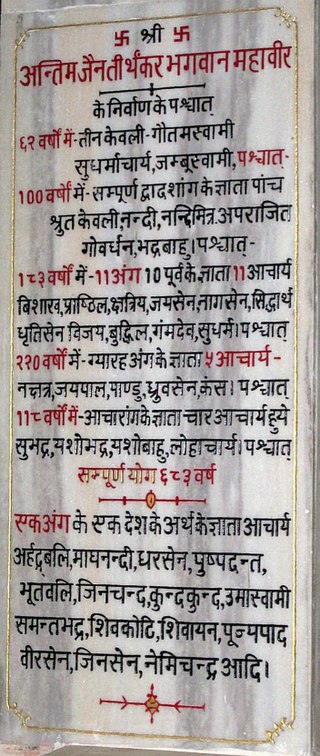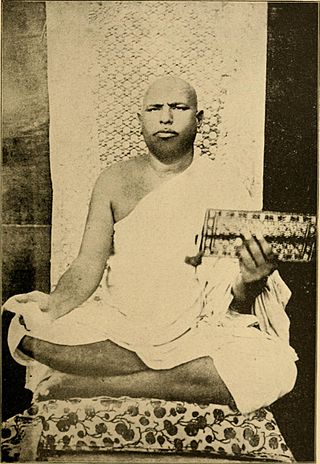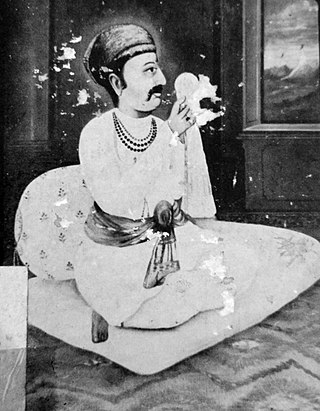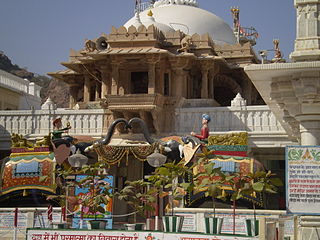
The Śvetāmbara is one of the two main branches of Jainism, the other being the Digambara. Śvetāmbara in Sanskrit means "white-clad", and refers to its ascetics' practice of wearing white clothes, which sets it apart from the Digambara or "sky-clad" Jains whose ascetic practitioners go nude. Śvetāmbaras do not believe that ascetics must practice nudity.

Jainism has had a notable following in Gujarat. According to the 2011 Census of India, around 0.959% of the population of Gujarat is Jain. There are several old Jain temples that draw pilgrims from Jains around the world in places such as Palitana, Taranga, Sankheshwar, Idar.

Mūrtipūjaka, also known as Derāvāsī ("temple-dweller") or Mandir Mārgī, is the largest sect of Śvetāmbara Jainism. Mūrtipūjaka Jains differ from both Śvetāmbara Sthānakavāsī and Śvetāmbara Terāpanthī Jains in that they worship images of the Tīrthaṅkaras. Mūrtipūjaka may also generally describe members of both the Śvetāmbara and Digambara traditions who use idols (mūrti) in their worship (pūjā).

Jainism is a religion founded in ancient India. Jains trace their history through twenty-four tirthankara and revere Rishabhanatha as the first tirthankara. The last two tirthankara, the 23rd tirthankara Parshvanatha and the 24th tirthankara Mahavira are considered historical figures. According to Jain texts, the 22nd tirthankara Neminatha lived about 84,000 years ago and was the cousin of Krishna.

A Pattavali, Sthaviravali or Theravali, is a record of a spiritual lineage of heads of monastic orders. They are thus spiritual genealogies. It is generally presumed that two successive names are teacher and pupil. The term is applicable for all Indian religions, but is generally used for Jain monastic orders.

Acharya Vijayanand Suri, also known as Atmaramji of Gujranwala, was the first Swetambar Murtipujaka Jain monk in modern times to receive the title of Acharya. Born and raised in Punjab, he was initiated as a Sthanakvasi monk and later joined the Murtipujaka tradition. He travelled extensively in Gujarat, Rajputana and Punjab; he organised and reformed Jain community, ascetic orders and literature. He wrote several books in Hindi and was invited to the first World Parliament of Religions in 1893 which was attended by Virchand Gandhi later.

Acharya Vijay Vallabhsuri was a Jain monk. He was a disciple of Vijayanandsuri. He worked in Punjab so he was given honorific Punjab Kesari.

Hiravijaya (1526–1595), also known as Muni Hiravijayji and Hiravijay Suri, was a high priest of the Tapa Gaccha monastic order, following the Jain Śvetāmbara tradition. He is known for propounding the Jain philosophy to Mughal Emperor Akbar and turning him towards vegetarianism.

Ghantakarna Mahavira is one of the fifty-two viras of Svetambara Jainism. He is chiefly associated with Tapa Gaccha, a monastic lineage. He was a deity of the Jain tantrik tradition. There is a shrine dedicated to him at the Mahudi Jain Temple established by Buddhisagar Suri, a Jain monk, in nineteenth century. It is one of the popular Jain pilgrimage centres of India.

Shantidas Jhaveri was an Indian Jain jeweller, bullion trader (sarraf) and moneylender (sahukar) during the Mughal era. He was the wealthiest merchant in the Ahmedabad city during the 17th century.

Kharatara Gaccha is one of Śvetāmbara Murtipujaka Gacchas. It is also called the Vidhisangha or Vidhimarga, as they regard their practices as scripturally correct.

The Palitana temples, often known only as Palitana, are a large complex of Jain temples located on Shatrunjaya hills near Palitana in Bhavnagar district, Gujarat, India. Also known as "Padliptapur of Kathiawad" in historic texts, the dense collection of almost 900 small shrines and large temples have led many to call Palitana the "city of temples". It is one of the most sacred sites of the Śvetāmbara tradition within Jainism. The earliest temples in the complex date as far back as the 11th century CE.

Jainism is an Indian religion which is traditionally believed to be propagated by twenty-four spiritual teachers known as tirthankara. Broadly, Jainism is divided into two major schools of thought, Digambara and Śvetāmbara. These are further divided into different sub-sects and traditions. While there are differences in practices, the core philosophy and main principles of each sect is the same.
Gaccha, alternatively spelled as Gachchha, is a monastic order, along with lay followers, of the image worshipping Murtipujaka Śvetāmbara sect of Jainism.
Jain festivals occur on designated days of the year. Jain festivals are either related to life events of Tirthankara or they are performed with intention of purification of soul.

Nakodaji Tirth is a major Śvetāmbara Jain tirth of Tirthankara Parshwanatha in the Indian state of Rajasthan, located between the villages of Vikrampura and Nakoda in Barmer District. The temple houses the icon of Nakoda Bhairava, a prominent Śvetāmbara guardian deity.
Upkeśa Gaccha is the oldest gaccha of Śvetāmbara Jainism. It is one of the 84 gacchas of the Śvetāmbara sect that were once in existence. Unlike most other gacchas that follow Mahavira's lineage and begin with his disciple Sudharmaswami, it follows the lineage of the 23rd Tirthankara Parshvanatha and is said to have begun with his prime disciple Ganadhara Shubhadatta. It went extinct in about 1930 CE.

Aryarakshitsuri was Śvetāmbara Jain monk and the founder of the Achal Gaccha of the Śvetāmbara sect of Jainism. He was a contemporary of Hemchandrasuri and is said to have met him.

Śāsana Samrāt Ācārya Nemisuri Mahārāja Sāheb was a 20th century CE Śvetāmbara Jain ascetic, philosopher, researcher, reformer, and the head of the Tapa Gaccha. He is best known for his efforts in preserving the Jain literature and protection of major pilgrimage sites such as Palitana temples, Girnar Jain temples, and Taranga Jain temples.
















